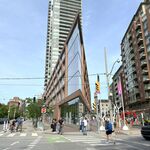Thanks to the SmartTrack station consultations over the past few weeks, we now have a full end-to-end picture of the track configuration that Metrolinx envisages for the Weston Subdivision.
I have combined the conceptual track layout from the New Track and Facilities EA (
massive PDF here) with the illustrated platform layouts from the
St. Clair/Old Weston (Stockyards) and
King/Liberty (Liberty Village) public consultations to create a diagram of the tracks proposed by Metrolinx for the relatively near future:
View attachment 369757
View attachment 369756
In general I am very pleased with this proposed design, as it will be able to support a substantial amount of service. My biggest concern is that Metrolinx does not seem to be rationalizing the 4 tracks in to express/local pairs. This creates a number of problems:
1. Providing platforms on all 4 Kitchener Line tracks at Liberty Village requires eliminating at least 1 of the planned Barrie Line and Milton Line tracks. The conceptual site plan from the 18 November public consultation shows the Milton line being reduced to a single track, rather than the double track which had always been planned until now. Furthermore it shows the northbound Barrie Line track crashing into the north pier of the station's overpass at Sudbury Street.
View attachment 369759
2. As I have described before, mixing high-frequency local and express services on the same tracks severely limits the speed and reliability of express services. If local service runs every 15 minutes, then the express service can be at most 7 minutes faster than it before catching up to it. Today's express service is already 12 minutes faster than local services, and the number of local stations is only going to increase further. At a service planning level, Metrolinx does seem to be aware of this limitation, given that on Page 28 of the 2021 Kitchener Expansion Business Case analysis it states that all trains continuing west of Pearson junction (Wice) will operate express.
View attachment 369760
This, combined with the lack of talk of a rail-to-rail grade separation at said junction, suggests that the concept is for the north pair of tracks to serve express services, while the south pair is primarily used by a local service to the airport.
Here is how I would rationalize the track configuration to better suit that arrangement. I have reduced the two SmartTrack stations to a single island platform on the local tracks, to reduce construction costs and ensure that all 8 tracks can be maintained at Liberty Village. I have also slightly altered Pearson (Wice) and Bramalea (Halwest) junctions to reduce conflicts.
I have coloured the "express" pair in a much darker shade of green, purely to illustrate the typical use of each track.
View attachment 369766
View attachment 369767
View attachment 369765
Here's a conceptual service pattern which could operate on my slightly-adjusted track layout. I have increased the variety of services compared to the pattern described in the Business Case. Their stopping patterns were probably oversimplified since service details east of Bramalea are not yet required at this stage of that project which is focused on the tracks west of Bramalea.
In my service concept:
- Trains coming in from Kitchener or London should not stop at Malton, due to its lack of regional importance. However they should stop at Mount Dennis and/or Bloor-Dundas due to their rapid transit connections.
- Given that there are 3 tracks west of Pearson Junction, it is possible to run 2 local trains per hour to Bramalea, providing some extra connectivity and frequency to local stations. If the quad track were extended west through Malton station, it would become possible to run 4 tph local to Bramalea, providing an interleaved 8-minute service east of Pearson Junction. The at-grade conflict at Pearson Junction is not a problem with two 4tph services as long as the services are regular and reliable (which the local services would be).
Split lines represent peak-only services
View attachment 369764






